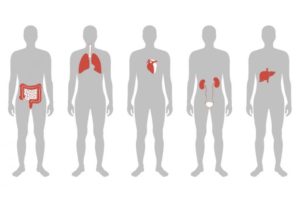Scientists at Tufts University and the Broad Institute of Harvard and MIT have developed a lipid nanoparticle (LNP) technology that can package and deliver CRISPR gene editing machinery specifically to the liver. Their studies in mice demonstrated use of the LNP technology to shuttle CRISPR Cas9 mRNA and guide RNA directly to the liver, to knock down a gene called Angptl3. The strategy resulted in up to 57% reductions in blood cholesterol levels with the effects lasting for several months following a single injection.
“We envision that with this LNP platform in hand, we could now make CRISPR a practical and safe approach to treat a broad spectrum of liver diseases or disorders,” said Zachary Glass, a graduate student in the lab of Qiaobing Xu, PhD, associate professor of biomedical engineering at Tufts’ School of Engineering and corresponding author of the study. Min Qiu, PhD, postdoctoral researcher in Xu’s lab and Glass are co-first authors of the study, in which they concluded: “The system we established here offers a clinically viable approach for liver-specific delivery of CRISPR-Cas9–based genome editing tools.” The paper, titled, “Lipid nanoparticle-mediated codelivery of Cas9 mRNA and single-guide RNA achieves liver-specific in vivo genome editing of Angptl3,” was published in Proceedings of the National Academy of Sciences (PNAS).
The problem of high cholesterol affects more than 29 million people in the United States, according to CDC figures cited by Tufts University. However, the condition is complex, and not easy to treat, as it can be linked to multiple genes, as well as to nutritional and lifestyle choices. And as the authors pointed out, “For complex polygenic disorders such as hyperlipidemia, which are the result of a combination of the effects of a large number of genes as well as nutritional and environmental influences, identifying a single gene to repair may be challenging.”
An alternative strategy is to identify mutations in single genes that are found naturally in the human population, and which give carriers protection against hyperlipidemia. “By introducing these protective loci, it may be possible to develop a single therapeutic that is effective for many patients, regardless of their specific genetic backgrounds,” the authors continued.
CRISPR has emerged as a powerful genome editing tool that could feasibly change the way we treat disease by modifying our genes. The challenge when altering the genetics of our cells, however, is how to do it safely and effectively, and specifically target the gene, tissue, and organ that needs treatment. “… the application of this technology has been limited by the technical challenge of achieving safe, effective, and specific in vivo delivery of the CRISPR-Cas9 genome editing components,” the investigators commented. “To facilitate the clinical translation of mRNA-mediated CRISPR technology, delivery systems with superb safety, high specificity, and efficacy are needed.”
The Tufts and Broad researchers now report on the development of unique nanoparticles comprised of lipids—fat molecules—that can package up and deliver CRISPR gene editing components specifically to the liver. For their studies, the researchers focused on using the technology to knock down the gene that codes for angiopoietin-like 3 (Angptl3), an enzyme that tamps down the activity of other enzymes—lipases—that help break down cholesterol.

“If we can replicate that condition by knocking out the angptl3 gene in others, we have a good chance of having a safe and long-term solution to high cholesterol,” said Xu. “We just have to make sure we deliver the gene editing package specifically to the liver so as not to create unwanted side effects.”
The LNP technology that the team has now developed to deliver the CRISPR elements builds on earlier work by Xu and colleagues at Tufts, through which they developed LNPs with as much as 90% efficiency in delivering mRNA into cells. A unique feature of those nanoparticles was the presence of disulfide bonds between the long lipid chains. Outside the cells, the LNPs form a stable spherical structure that locks in their contents. When they are inside a cell, the environment within breaks the disulfide bonds to disassemble the nanoparticles. The contents are then quickly and efficiently released into the cell. By preventing loss outside the cell, the LNPs can have a much higher yield in delivering their contents.
The trick to making a better LNP that specifically targets the liver, was customizing the nanoparticle components that form the bubble around the mRNA. The LNPs are made up of long chain lipids that have a charged or polar head that is attracted to water, a carbon chain tail that points toward the middle of the bubble containing the payload, and a chemical linker between them. Also present are polyethylene glycol, and some cholesterol— which has a normal role in lipid membranes to make them less leaky—to hold their contents better.
The researchers found that the nature and relative ratio of these components appeared to have profound effects on the delivery of mRNA into the liver, so they evaluated LNPs with many combinations of heads, tails, linkers, and ratios among all components for their ability to target liver cells. Because the in vitro potency of an LNP formulation rarely reflects its in vivo performance, they directly evaluated the delivery specificity and efficacy in mice that have a reporter gene in their cells that lights up red when genome editing occurs. Ultimately, they found a CRISPR mRNA-loaded LNP (306-O12B LNP) that lit up just the liver in mice, showing that it could specifically and efficiently deliver gene-editing tools into the liver.
The team then gave experimental mice a single injection of the 306-O12B LNP, packed with mRNA coding for CRISPR-Cas9 and a single-guide RNA targeting Angptl3. The treatment resulted in a profound reduction in LDL cholesterol, by as much as 57%, and about a 29% reduction in triglyceride levels. By comparison, an existing, FDA-approved version of CRISPR mRNA-loaded LNPs could only reduce LDL cholesterol by at most 15.7% and triglycerides by 16.3% when tested in mice. “Taken together, these results indicated that our 306-O12B LNP is more efficient than the gold standard MC-3 LNP in inducing loss-of-function mutations in Angptl3 through CRISPR-Cas9–based genome editing,” they wrote.
Encouragingly, levels of both LDL cholesterol and triglyceride remained at the reduced levels for at least 100 days after a single injection of the liver-targeting, CRISPR-loaded 306-O12B LNPs. The researchers speculate that the effect may last much longer, and is perhaps limited only by the slow turnover of cells in the liver, which can occur over a period of about a year.
“Although our thorough analysis of serum lipid levels was only performed out to 100 d after administration, sequencing data indicated durable genomic editing at least to 150 d,” they wrote. “Our data indicates a very slight reduction in genomic editing efficiency over time, which may reflect the slow turnover of hepatocytes in the liver, which have a predicted life of ∼300 d. Regardless, our data are not incompatible with the possibility of therapeutic efficacy out to 1 y.”
The reduction of cholesterol and triglycerides was also dose dependent, so their levels could be adjusted by injecting fewer or more LNPs in the single shot, the researchers suggested. “While a thorough clinical dosage analysis falls beyond the scope of this study, we did observe a dose-dependent reduction in serum ANGPTL3 levels upon a single injection of 306-O12B LNP. This indicates to us that in a clinical setting, our LNP system could achieve similar dose- and frequency-dependent knockdown …” they wrote.
“CRISPR is one of the most powerful therapeutic tools for the treatment of diseases with a genetic etiology,” said Qiu. “We have recently seen the first human clinical trial for CRISPR therapy enabled by LNP delivery to be administered systemically to edit genes inside the human body. Our LNP platform developed here holds great potential for clinical translation.”
The authors said that their study outcomes may “advance the systemic delivery of CRISPR genome editing machinery in the clinic.” While they acknowledge that further, more detailed preclinical studies will be needed, they concluded: “Overall we demonstrate here that 3060O12B LNP is a highly potent and safe nonviral delivery platform for clinically relevant liver-specific CRISPR-Cas9-based genome editing.”


